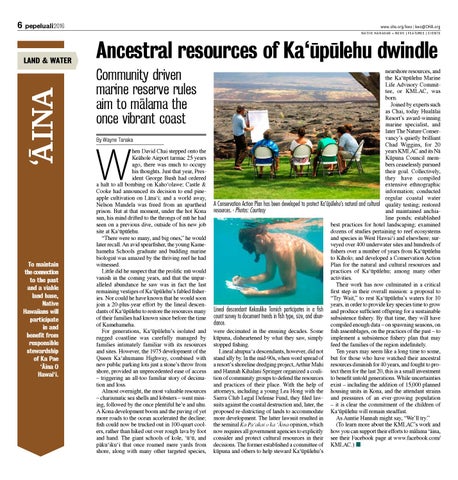6
pepeluali2016
www.oha.org/kwo | kwo@OHA.org
n at i v e hawa i i a n » n e w s | f e at u r e s | e v e n t s
Ancestral resources of Ka‘u¯pu¯lehu dwindle Community driven marine reserve rules aim to ma¯lama the once vibrant coast By Wayne Tanaka
W To maintain the connection to the past and a viable land base, Native Hawaiians will participate in and benefit from responsible stewardship of Ka Pae ‘A¯ina O Hawai‘i.
hen David Chai stepped onto the Keähole Airport tarmac 25 years ago, there was much to occupy his thoughts. Just that year, President George Bush had ordered a halt to all bombing on Kaho‘olawe; Castle & Cooke had announced its decision to end pineapple cultivation on Läna‘i; and a world away, Nelson Mandela was freed from an apartheid prison. But at that moment, under the hot Kona sun, his mind drifted to the throngs of mü he had seen on a previous dive, outside of his new job site at Ka‘üpülehu. “There were so many, and big ones,” he would later recall. An avid spearfisher, the young Kamehameha Schools graduate and budding marine biologist was amazed by the thriving reef he had witnessed. Little did he suspect that the prolific mü would vanish in the coming years, and that the unparalleled abundance he saw was in fact the last remaining vestiges of Ka‘üpülehu’s fabled fisheries. Nor could he have known that he would soon join a 20-plus-year effort by the lineal descendants of Ka‘üpülehu to restore the resources many of their families had known since before the time of Kamehameha. For generations, Ka‘üpülehu’s isolated and rugged coastline was carefully managed by families intimately familiar with its resources and sites. However, the 1975 development of the Queen Ka‘ahumanu Highway, combined with new public parking lots just a stone’s throw from shore, provided an unprecedented ease of access – triggering an all-too familiar story of decimation and loss. Almost overnight, the most valuable resources – charismatic sea shells and lobsters – went missing, followed by the once plentiful he‘e and uhu. A Kona development boom and the paving of yet more roads to the ocean accelerated the decline; fish could now be trucked out in 100-quart coolers, rather than hiked out over rough lava by foot and hand. The giant schools of kole, ‘ü‘ü, and päku‘iku‘i that once roamed mere yards from shore, along with many other targeted species,
nearshore resources, and the Ka‘üpülehu Marine Life Advisory Committee, or KMLAC, was born. Joined by experts such as Chai, today Hualälai Resort’s award-winning marine specialist, and later The Nature Conservancy’s quietly brilliant Chad Wiggins, for 20 years KMLAC and its Nä Küpuna Council members ceaselessly pursued their goal. Collectively, they have compiled extensive ethnographic information; conducted regular coastal water A Conservation Action Plan has been developed to protect Ka‘u¯pu¯lehu’s natural and cultural quality testing; restored resources. - Photos: Courtesy and maintained anchialine ponds; established best practices for hotel landscaping; examined dozens of studies pertaining to reef ecosystems and species in West Hawai‘i and elsewhere; surveyed over 400 underwater sites and hundreds of fishers over a number of years from Ka‘üpülehu to Kïholo; and developed a Conservation Action Plan for the natural and cultural resources and practices of Ka‘üpülehu; among many other activities. Their work has now culminated in a critical first step in their overall mission: a proposal to “Try Wait,” to rest Ka‘üpülehu’s waters for 10 years, in order to provide key species time to grow Lineal descendant Kekaulike Tomich participates in a fish and produce sufficient offspring for a sustainable count survey to document trends in fish type, size, and abun- subsistence fishery. By that time, they will have dance. compiled enough data – on spawning seasons, on were decimated in the ensuing decades. Some fish assemblages, on the practices of the past – to küpuna, disheartened by what they saw, simply implement a subsistence fishery plan that may stopped fishing. feed the families of the region indefinitely. Lineal ahupua‘a descendants, however, did not Ten years may seem like a long time to some, stand idly by. In the mid-90s, when word spread of but for those who have watched their ancestral a resort’s shoreline dredging project, Arthur Mahi resources diminish for 40 years, and fought to proand Hannah Kihalani Springer organized a coali- tect them for the last 20, this is a small investment tion of community groups to defend the resources to benefit untold generations. While uncertainties and practices of their place. With the help of exist – including the addition of 15,000 planned attorneys, including a young Lea Hong with the housing units in Kona, and the attendant strains Sierra Club Legal Defense Fund, they filed law- and pressures of an ever-growing population suits against the coastal destruction and, later, the – it is clear the commitment of the children of proposed re-districting of lands to accommodate Ka‘üpülehu will remain steadfast. more development. The latter lawsuit resulted in As Auntie Hannah might say, “We’ll try.” the seminal Ka Pa‘akai o ka ‘Äina opinion, which (To learn more about the KMLAC’s work and now requires all government agencies to explicitly how you can support their efforts to mälama ‘äina, consider and protect cultural resources in their see their Facebook page at www.facebook.com/ decisions. The former established a committee of KMLAC.) ¢ küpuna and others to help steward Ka‘üpülehu’s
